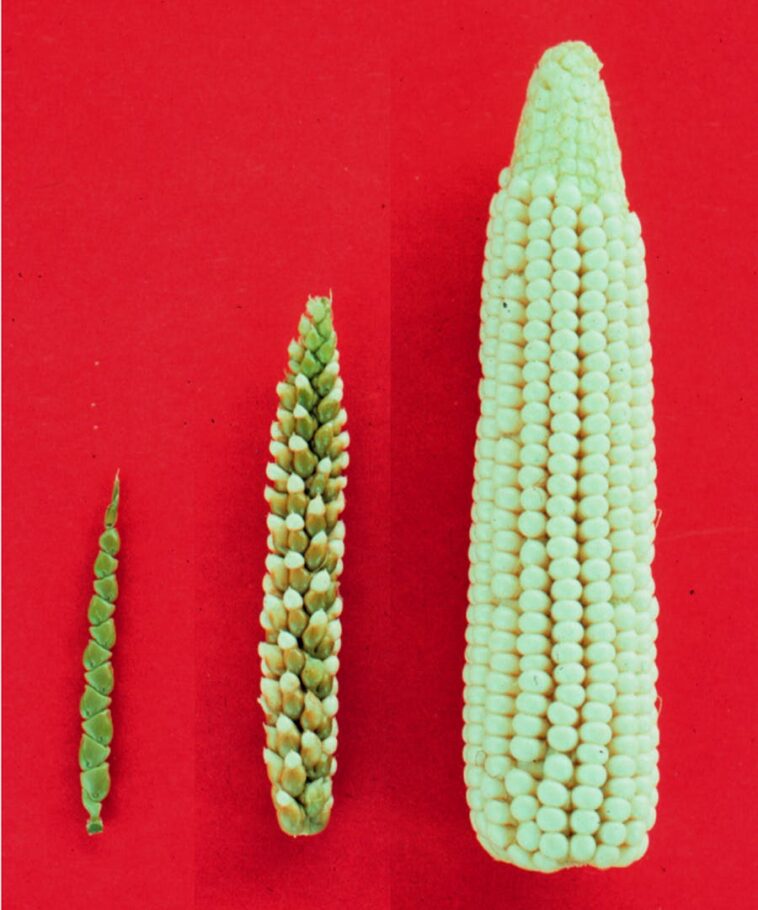Genetic Manipulation Is Neolithic
Broccoli, corn, bananas, tomatoes, potatoes, celery……you name it. Almost all of the vegetables and fruits we eat today are drastically different than they were before humans got their meddling hands involved. The food on your plate is genetically engineered and has been for the the last 10,000 years.
Now before you poo poo me for taking the conversation on GMO’s out of context…..please hear me out.
When humans moved from being hunter gatherers into the Neolithic era, it marked the transition in human history from small, nomadic bands of hunter-gatherers to larger agricultural settlements and early civilization. They began domesticating crops and livestock and over time they found that certain plants and animals tasted better than others. This resulted in human selecting seeds from their favorite varieties and selectively planting only those. (The same occurred with breeding animals, but we’ll focus on plants for now.)
For example, take a look at corn.

Teosinte…..Corn before corn was cool.
In the beginning, the corn plant(Teosinte) looked nothing like today’s corn. It was just another tall grass that went to seed. Our ancestors started planting seeds within the species and noticed that some mutations (without knowing what a mutation was) made larger kernels, more kernels, tastier kernels, different shapes etc. The farmers then replanted seeds from the mutated corn plants, “selecting” for the traits that they wanted. Traditional breeding of different grass species led to the development, over time, of modern corn from its teosinte ancestor. And as you can see from the image above, the changes are drastic.
It’s like an evolution ‘hack’. Humans accelerated changes in plant species via manual trait selection based on perceived beneficial mutations.
In this attempt to make better food, early humans patiently bred generation upon generation of plant. They had no way to make mutations occur, they only knew that occasionally they did. This is human guided artificial selection. It took over 10,000 years of human selected mutations to create many of the varieties of food we eat today.

Humans did to our modern foods, what dog breeders did with Chihuahuas. Over the last 10000 years, human selective breed has practically created a new creature!
The genetic modification timeline

10,000-8000 BCE Humans use traditional modification methods like selective breeding and cross-breeding to breed plants and animals with more desirable traits.
1866 Gregor Mendel, an Austrian monk, breeds two different types of peas and identifies the basic process of genetics.
1922 The first hybrid corn is produced and sold commercially.
1940 Plant breeders learn to use radiation or chemicals to randomly change an organism’s DNA.
1953 Building on the discoveries of chemist Rosalind Franklin, scientists James Watson and Francis Crick identify the structure of DNA.
1973 Biochemists Herbert Boyer and Stanley Cohen develop genetic engineering by inserting DNA from one bacteria into another.
1982 FDA approves the first consumer GMO product developed through genetic engineering: human insulin to treat diabetes.
1986 The federal government establishes the Coordinated Framework for the Regulation of Biotechnology. This policy describes how the U.S. Food and Drug Administration (FDA), U.S. Environmental Protection Agency (EPA), and U.S. Department of Agriculture (USDA) work together to regulate the safety of GMOs.
1992 FDA policy states that foods from GMO plants must meet the same requirements, including the same safety standards, as foods derived from traditionally bred plants.
1994 The first GMO produce created through genetic engineering—a GMO tomato—becomes available for sale after studies evaluated by federal agencies proved it to be as safe as traditionally bred tomatoes.
1990s The first wave of GMO produce created through genetic engineering becomes available to consumers: summer squash, soybeans, cotton, corn, papayas, tomatoes, potatoes, and canola. Not all are still available for sale.
2003 The World Health Organization (WHO) and the Food and Agriculture Organization (FAO) of the United Nations develop international guidelines and standards to determine the safety of GMO foods.
2005 GMO alfalfa and sugar beets are available for sale in the United States.
2015 FDA approves an application for the first genetic modification in an animal for use as food, a genetically engineered salmon.
2016 Congress passes a law requiring labeling for some foods produced through genetic engineering and uses the term “bioengineered,” which will start to appear on some foods.
2017 GMO apples are available for sale in the U.S.
2019 FDA completes consultation on first food from a genome edited plant.
[/et_pb_text][/et_pb_column][/et_pb_row][et_pb_row _builder_version=”4.16″ _module_preset=”default” global_colors_info=”{}”][et_pb_column type=”4_4″ _builder_version=”4.16″ _module_preset=”default” global_colors_info=”{}”][et_pb_text _builder_version=”4.16″ _module_preset=”default” global_colors_info=”{}”]
3 main types genetic modification
Selective Breeding (“traditional breeding”)
Early plant breeders looked for and cross-bred plants that had the characteristics they wanted. They have crossed plants within a species and across species beginning thousands of years ago. Traditional breeding of different grass species led to the development, over time, of modern corn from its teosinte ancestor(see image below). And today’s bread wheat was created by crossing, over time, at least 11 different species. In the 1800’s, farmers and scientists began intentionally cross-breeding plants within a species and mixing the genetic makeup of different plants together to select for new desirable traits.
In 1866 Gregor Mendel, an Austrian monk, famously breeds two different types of peas and identifies the basic process of genetics. Then in 1922, the first hybrid corn is produced and sold commercially.

In just a few thousand years the banana went from a seed filled, barely palatable, wild variety, to the sweet treat we have today.
Genetic Engineering (“GE” / “GMO”)
In the late 20th century, advances in technology have enabled us to expand the genetic diversity of crops. For years, university, government and company scientists intensively researched and refined this process. A major result has been genetically modified seeds that maintain or increase the yield of crops while requiring less land and fewer inputs, both of which lessen the impact of agriculture on the environment and reduce costs for farmers.
While selective breeding and mutagenesis methods usually involve crossing or altering thousands of genes, genetic engineering enables breeders to select a trait or characteristic that exists in nature and insert the associated gene(s) into the target plant. Genetic engineering also allows a breeder to make changes in a plant’s makeup without any insertions whatsoever, for example, by silencing (“turning off”) existing genes.
Mutagenesis (“mutation breeding”)
Beginning in the 1920s, breeders started seeking more diversity than they were able to achieve through selective breeding to create new traits. They began to make changes in plant deoxyribonucleic acid (DNA) by exposing seeds to chemicals or gamma irradiation and then selecting the plants that displayed the traits they wanted. More than 3,200 varieties of commonly consumed plant products have been developed using mutagenesis, including varieties of red grapefruit, bananas, peanuts, peppermint and rice.
Questions? Comments?




GIPHY App Key not set. Please check settings